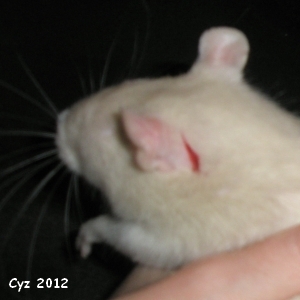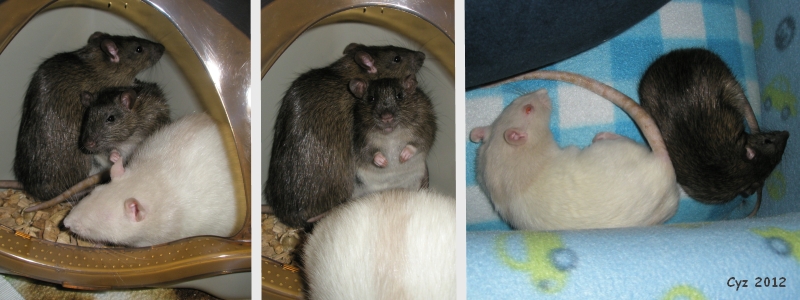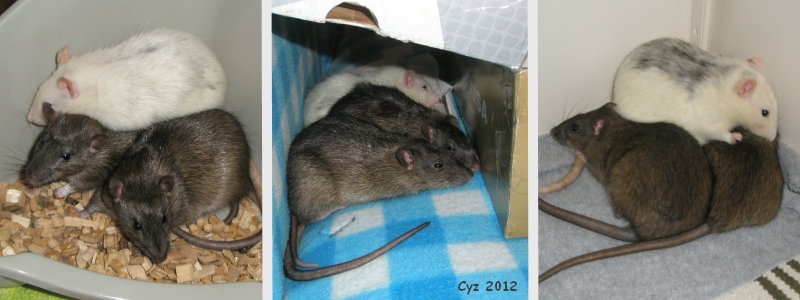Figure 3: Problematic introduction involving territorial aggression with resultant bite wound to ear (Yasmine)
Case and photos
History
The rat rescue informed us that when Yasmine (fawn hooded intact female) was brought in as a young rat, she had initially been terrified of her new (adult?) cage-mates, to the point of cowering in a corner of the cage and screaming as soon as another rat approached her. This behaviour subsided over the course of several weeks, after which she settled well into the small group of approximately six rats.
Adoption & prior introductions
Yasmine was adopted from the rat rescue at the age of about 1 year old. One month after her adoption her left eye was surgically removed by a veterinarian due to medical problems.
Yasmine’s introduction to the resident adolescent (castrated) male rat was uneventful; they immediately got along very well. When two additional adult (intact) female rats were introduced about one month later, that introduction was also uneventful, although Yasmine often claimed (and argued over) the Wodent Wheel that is inside their cage.
Yasmine’s exact position within the dominance hierarchy is unclear (in fact, the entire dominance hierarchy within this group is unclear to me…), but she generally gets along well with the other rats. She is a calm rat, who will venture out of the cage during free-range time, but returns relatively quickly to go back to sleep in a house.
Introduction
When Yasmine is approximately 1 year and 10 months of age, two (castrated) 3 month-old semi-wild male rats (Gambit & Twix) are added to the resident rat group, which at that time consists of one adult castrated male (Joshua) and two adult intact domesticated females (Yasmine & Jessie).
Gambit gets along quite well with the resident rats. Twix, however, although curious, is also very fearful and displays defensive aggression: squeaking, hissing, piloerection (raised fur), and very clear open-mouth tooth displays, during which he focusses intently on the other rats’ head/face and occasionally even mock-nips (slowly).
Yasmine approaches Twix or passes him by, but when he displays aggression she hesitates and shies away. She tends to ignore the newcomers and avoid interaction.
The other resident rats are more decisive in their communication towards the newcomers: they either ignore certain fear/aggression behaviours (especially Jessie does not appear too interested in or impressed by the newcomers), or they respond with displays of dominance (piloerection, pinning, powergrooming). Interestingly, quite early on in the introduction Jessie crawls on top of the frightened newcomers and curls up to sleep. In addition, in a combined display of dominance towards Twix, Joshua and Jessie simultaneously crawl underneath him.
Further on in the introduction, both Joshua and Gambit occasionally appear to intervene during agonistic interactions, by placing themselves between the other rats.
Due to lack of a suitable introduction area (non-territory, not too big or small, easily accessible) the group is initially placed together on (parts of) the freerange area, i.e. two large couches that consist of several individual detachable chairs. Several sessions are held each day, with varying duration (often for several hours).
In addition, the two groups are occasionally switched into each other’s cage section, to let them become accustomed to each other’s scent.
On day 6 of the introduction, because things appear to be going well, and because it is impossible to keep Gambit on the designated couch area (he is an excellent jumper), the group is also allowed to venture into the large fully decorated cage.
At 01:30 hours (technically day 7) there is a tense interaction inside the cage between Twix (with raised fur) and Yasmine. It is unintentionally disturbed by the supervisor, at which point Twix approaches the supervisor. When Yasmine subsequently “tugs” on his back, Twix swirls around and the two rats roll across the floor of the cage. The fight is broken up by the supervisor. Twix pauses for a second, then lunge-jumps towards/onto Yasmine. The two rats are separated and inspected for injuries.
 |
Yasmine has sustained an approximately 1cm long clean-cut skin-deep wound a few millimeters behind the base of her left ear. There is minimal bleeding and she does not appear to be in discomfort. The wound heals within a few hours.
The cause for the bite wound is suspected to be a combination of Yasmine’s character, her previous introduction experiences, her apparent hesitation to set firm boundaries for the newcomers, and Twix’s stronger fight/flight instinct combined with an increased level of fear and skittishness. In addition, it is possible that the unexpected interruption led to a sequence of events that would not have occurred if Twix had not turned his back on Yasmine.
After a two-day break, the introduction is continued.
In an attempt to increase the supervisor’s control over the situation, as well as prevent further avoidance tactics being used by the rats, the introduction is moved into a section of the large cage: floor surface = 90x56cm, height = 56cm. Constant close supervision is required.
During the following days, while reviewing video footage of the introduction, the supervisor notices that Yasmine could be interpreting the human interruption of her (agonistic) interactions with Twix as a “scolding” directed at herself. The supervisor changes her tactics:
- Instead of scolding Twix during agonistic interactions, Yasmine is praised and petted.
- When Twix is fearful, he is held and petted until he calms down.
- Whenever possible, one of the other rats (who have already progressed further in the introduction process) is placed within close proximity of Twix and Yasmine; this appears to distract Twix and lessen his fearfulness and aggression towards Yasmine.
In addition, from day 9 of the introduction, Twix is “forced” to spend several hours a day in close contact with the sleeping resident rats. This is done by placing all the rats on the couch in the middle of the afternoon, allowing the resident rats to seek out a sleeping spot behind a pillow, and then holding Twix next to them, while continuously stroking him and talking to him soothingly. (Note that this was done with bare hands, but thick gloves should be used if aggression is expected.)
By day 11 the introduction is going well; the cage has been added to the introduction area again. As days 12 through to 14 are spent at someone else’s house, the large cage at that less familiar location is used to house all the rats together for the first time. There are a few tense moments between Yasmine and Twix, but they do not escalate, and all goes well.
On day 15 (back home) the introduction is declared a success.
Outcome
Twix appears quite fond of Yasmine. No injuries have occurred since.
Photos
 The photo on the left, and the center photo, were taken on day 2 of the introduction. Twix (agouti berkshire) can be seen cowering in a corner of a semi-closed corner litter box, with his half-brother Gambit (agouti self). Twix displays defensive aggression towards Yasmine (beige hooded), who shies away from him. The photo on the right shows Yasmine and Twix sleeping next to each other on the couch. It was taken on day 9, during the “forced socialisation” in the middle of the afternoon. |
 In comparison, these pictures show how Joshua and Jessie handled the introduction. Photo on left: Day 1: Jessie sleeping on top of a fearful Twix (left) and Gambit. Note that Twix is intensely focussed on Yasmine, who is sitting to the left of them (not shown). Center photo: Day 4: Gambit, Twix (middle), and Jessie sleeping on the couch, underneath the opened lid of a large shoebox that is placed against the back of the couch. This was used as an “open” house, to provide the rats with a safe area to sleep in that was also easily accessible to the supervisor. Photo on right: Day 7: Joshua grooming Twix inside the cage. |
Case history and photos courtesy of Cyzahhe


